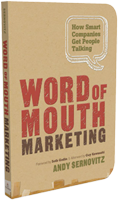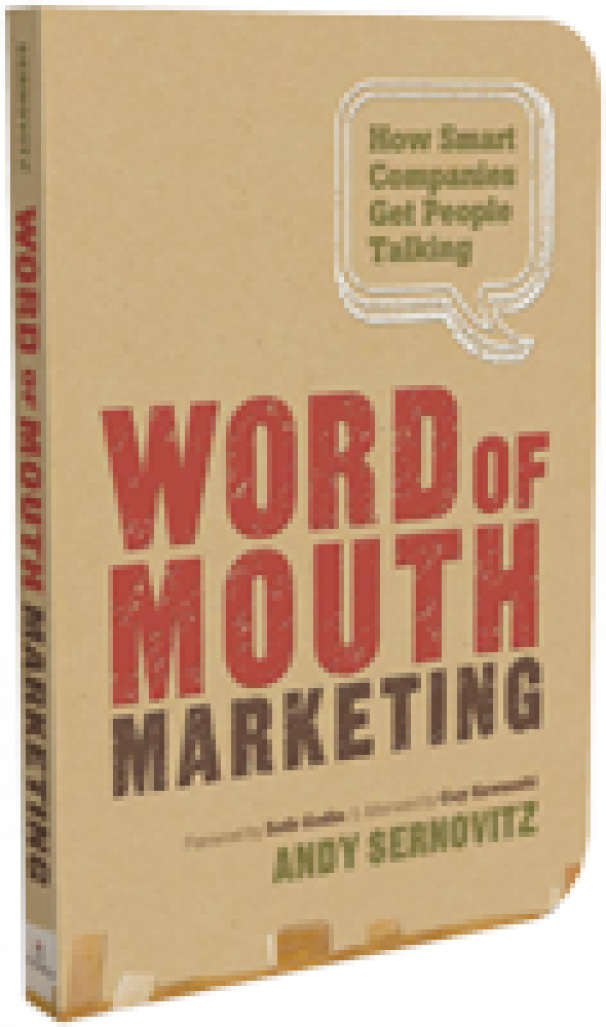[Welcome back to our Word of Mouth Marketing Lessons newsletter. This is text from the great issue all of our email subscribers just received. Sign yourself up using this handy form.]
 What sparks the irrepressible enthusiasm of Apple, IKEA, Harley-Davidson, Southwest, Zappos, and Patagonia fans?
What sparks the irrepressible enthusiasm of Apple, IKEA, Harley-Davidson, Southwest, Zappos, and Patagonia fans?
Why is everyone talking about a certain restaurant, car, band, or dry cleaner — and why are other businesses and products ignored? Why do some products become huge successes without a penny of promotion — and why do some multi-million-dollar advertising campaigns fail to get noticed?
In his book that just launched in paperback this week, word of mouth expert (and WordofMouth.org CEO) Andy Sernovitz walks through exactly how companies and causes of all sizes create passionate, loyal fans that do their marketing for them.
To celebrate the launch, we’re giving away the first chapter and are sending anyone who orders the book this week our Word of Mouth Workbook. (Details here.)
We also wanted to share a handful of some of the biggest ideas in the book with you. If you find these inspiring, you’ll absolutely love the book:
1. Happy customers are your greatest advertisers
2. A penny saved is a penny burned
3. If you don’t have respect, you don’t get great word of mouth
4. Real people don’t repeat marketing copy
5. Don’t drop your topic
6. The best tool to start word of mouth is the most obvious
7. BtoB word of mouth is exactly the same as BtoC word of mouth
8. Fixing problems is the most powerful marketing you can do
9. Participating in word of mouth doesn’t cause negative feedback
10. Download the first chapter
1. Happy customers are your greatest advertisers
Thrill them. Create amazing products. Provide excellent service. Go the extra mile. Make the experience remarkable. Fix problems. Make sure the work you do gets people energized, excited, and eager to tell a friend.
When people like you, they share you with their friends. They want to help you, they want to support your business, and they want their friends to enjoy what you offer. You will get more word of mouth from making people happy than anything else you could possibly do.
2. A penny saved is a penny burned
Spreadsheets are bad for word of mouth marketing. What looks good on them – gouging fees, shorter warranties, cheaper customer service – almost always hurts your word of mouth. Company after company, for example, tries to save a buck on low-cost customer service. It doesn’t work. When you add in the word of mouth math, you realize that any drop in customer service is a marketing disaster.
Think about what happens with every person who gets off the phone with a problem unresolved. They get angry. They tell their friends. The word of mouth starts flying, and it’s not pretty. Every day that the problem hangs out there unresolved starts another wave of negative word of mouth. What will it cost to replace those prospective customers?
3. If you don’t have respect, you don’t get great word of mouth
People won’t talk about you if they don’t respect you. Nobody talks positively about a company that they don’t trust or like. Nobody puts their name on the line for a company that will embarrass them in front of their friends.
Always be an honorable company. Make ethics part of everything you do. Be good to your customers. Talk to them. Fulfill their needs. Make people proud to tell your story to everyone they know.
4. Real people don’t repeat marketing copy
People won’t talk about you if you don’t give them something to say. But great topics can be hard for traditional marketers to see. They violate the rules of marketing. They aren’t planned, they aren’t corporate, and they are rarely official. It’s an exception when real people want to repeat your official company motto or carefully crafted theme. Instead, people latch onto the unexpected.
Instead of your corporate mission statement, think Zappos’ incredible return policy, RedEnvelope’s gorgeous packaging, or how Lou Mitchell’s in Chicago gives you fresh doughnut holes and Milk Duds while you wait for a table.
5. Don’t drop your topic
Here’s something to watch out for: Once you have a successful topic that is creating good word of mouth, you have to keep it up. Your commitment to the topic will set you apart just as much as the topic itself. If you ever stop doing whatever you were doing to get attention, people will notice.
Krispy Kreme had one of the most legendary word of mouth topics ever: Their “Hot Now” sign that meant fresh doughnuts were ready to be picked up. Everyone told a friend and brought them to the store to experience it. But then their doughnuts started appearing cold and shrink wrapped at convenience stores — and nobody talks about food you can buy at the gas station.
6. The best tool to start word of mouth is the most obvious
The first and foremost tool for creating word of mouth is the easiest and most obvious: asking nicely. Most people won’t talk until you ask them to. So ask often and ask everywhere. And once you do, you’ll find people are happy to talk.
But the challenge isn’t necessarily finding talkers, it’s triggering the talking action. Often the implied compliment of asking customers to help is what starts them down the road to becoming talkers. And don’t be shy — inviting your talkers to spread the word is a way of conferring status and making them insiders.
7. BtoB word of mouth is exactly the same as BtoC word of mouth
The first question every BtoB marketer asks is: “Does any of this work for business-to-business marketers?” Yep. It’s exactly the same.
Why? Because it’s not about the product — it’s about the people. The motivations that get people to talk about business-to-consumer products are the same as those that get people to recommend a business-to-business product. Your talkers are different, the topics change, and you’ll use different tools—but it still comes down to the same basic process: Find people who will talk about you, give them something to say, and make it easier for the conversation to take place.
8. Fixing problems is the most powerful marketing you can do
For every person a happy customer talks to, an unhappy customer tells five. But a formerly unhappy customer who is made happy? They tell ten people.
Think about this for a minute. Finding a way to make unhappy people happy is worth ten times more free word of mouth marketing than making them happy in the first place. It’s probably a comment on the sad state of customer service these days that people are so surprised by being treated well that they run around telling everyone about it when it happens. But it’s a great opportunity for you.
9. Participating in word of mouth doesn’t cause negative feedback
One of the most common managerial objections to word of mouth is, “What if someone says something bad?” Skittish marketers and lawyers are worried that if they start doing word of mouth, they will cause negative word of mouth.
Not participating because you’re worried about negative word of mouth is like refusing to go to the doctor because you don’t feel well. Participating in the word of mouth conversation doesn’t cause negative feedback. It gives you the tools to deal with it. So get out there, take part, join the conversation, and make new friends.
10. Download the first chapter
Download the first chapter to learn the definition of word of mouth marketing, the four rules of word of mouth, the three reasons people talk about you, and a whole lot more.
Download it: Click here
And remember! If you order this week (April 30 – May 5) from Amazon, send your receipt to workbook@wordofmouthbook.com and we’ll send you our 16-page Word of Mouth Workbook. Details here.



